Analysis of Australia's New Social Media Law and Its Implications
VerifiedAdded on 2023/01/19
|6
|1170
|43
Report
AI Summary
This report examines the 'Sharing of Abhorrent Violent Material Bill' passed by the Australian government in response to the spread of violent content on social media platforms. The law, enacted after the Christchurch terrorist attack videos went viral, penalizes social media companies for failing to remove or report violent content promptly. It defines offenses related to violent material and places new responsibilities on content providers and social media platforms. The legislation has sparked debate among tech companies, trade bodies, and the government, raising questions about media liberty, corporate responsibility, and the technical limitations in content screening. The report analyzes the bill's provisions, the legal and ethical implications, and the ongoing discussions between stakeholders to balance legislation with technological capabilities and corporate interests. The references included provide a detailed context of the social and political environment surrounding the bill.
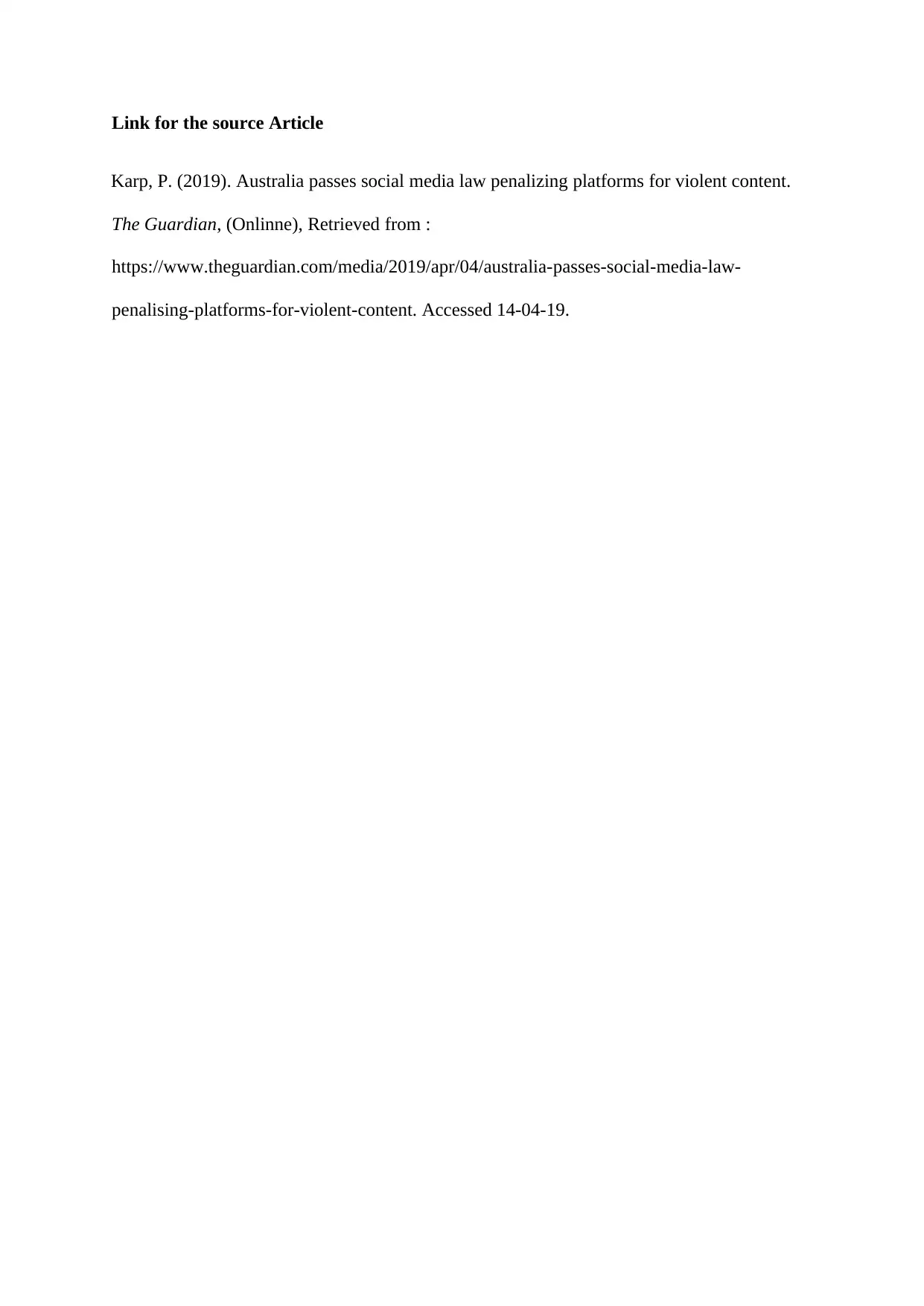
Link for the source Article
Karp, P. (2019). Australia passes social media law penalizing platforms for violent content.
The Guardian, (Onlinne), Retrieved from :
https://www.theguardian.com/media/2019/apr/04/australia-passes-social-media-law-
penalising-platforms-for-violent-content. Accessed 14-04-19.
Karp, P. (2019). Australia passes social media law penalizing platforms for violent content.
The Guardian, (Onlinne), Retrieved from :
https://www.theguardian.com/media/2019/apr/04/australia-passes-social-media-law-
penalising-platforms-for-violent-content. Accessed 14-04-19.
Paraphrase This Document
Need a fresh take? Get an instant paraphrase of this document with our AI Paraphraser
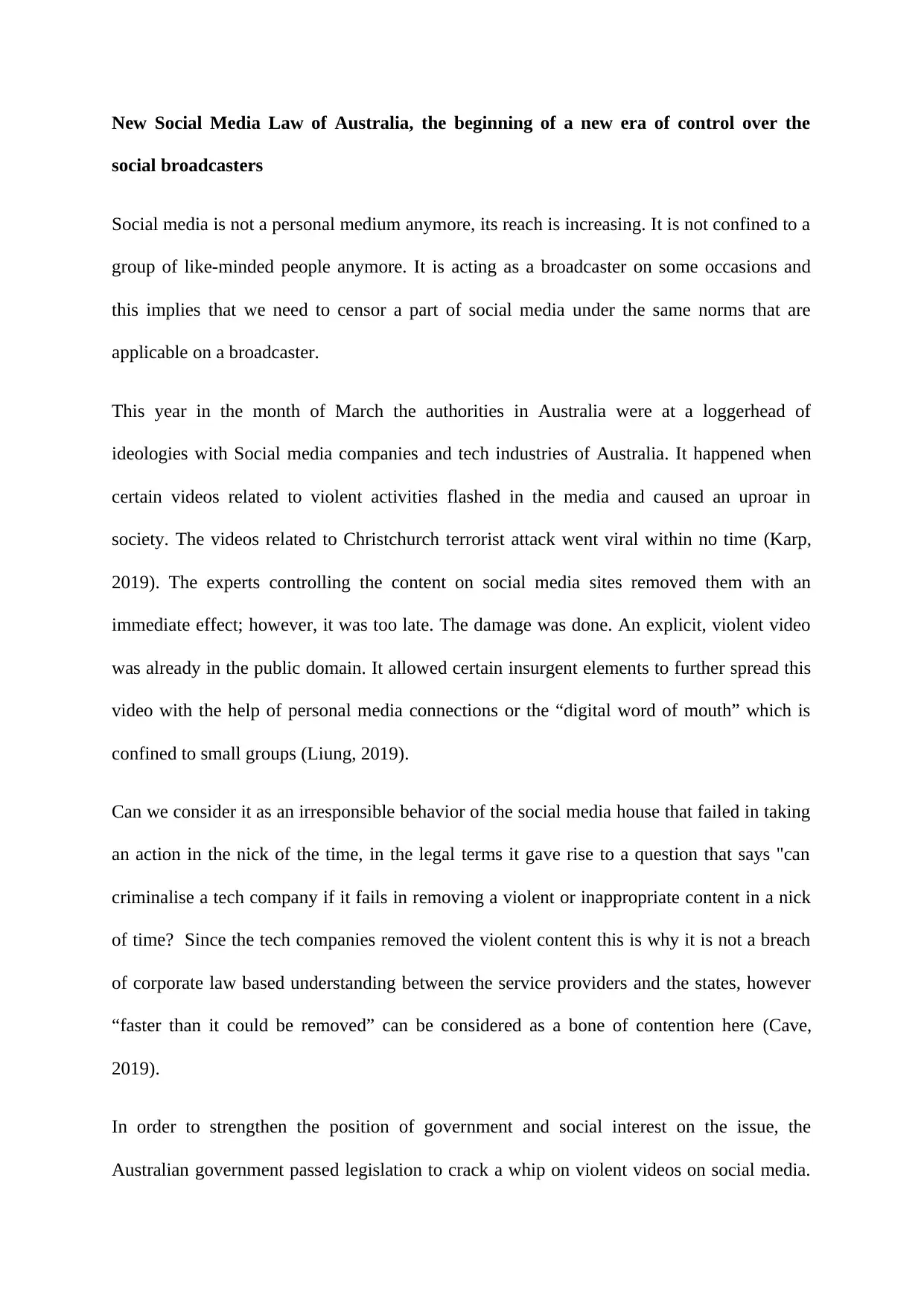
New Social Media Law of Australia, the beginning of a new era of control over the
social broadcasters
Social media is not a personal medium anymore, its reach is increasing. It is not confined to a
group of like-minded people anymore. It is acting as a broadcaster on some occasions and
this implies that we need to censor a part of social media under the same norms that are
applicable on a broadcaster.
This year in the month of March the authorities in Australia were at a loggerhead of
ideologies with Social media companies and tech industries of Australia. It happened when
certain videos related to violent activities flashed in the media and caused an uproar in
society. The videos related to Christchurch terrorist attack went viral within no time (Karp,
2019). The experts controlling the content on social media sites removed them with an
immediate effect; however, it was too late. The damage was done. An explicit, violent video
was already in the public domain. It allowed certain insurgent elements to further spread this
video with the help of personal media connections or the “digital word of mouth” which is
confined to small groups (Liung, 2019).
Can we consider it as an irresponsible behavior of the social media house that failed in taking
an action in the nick of the time, in the legal terms it gave rise to a question that says "can
criminalise a tech company if it fails in removing a violent or inappropriate content in a nick
of time? Since the tech companies removed the violent content this is why it is not a breach
of corporate law based understanding between the service providers and the states, however
“faster than it could be removed” can be considered as a bone of contention here (Cave,
2019).
In order to strengthen the position of government and social interest on the issue, the
Australian government passed legislation to crack a whip on violent videos on social media.
social broadcasters
Social media is not a personal medium anymore, its reach is increasing. It is not confined to a
group of like-minded people anymore. It is acting as a broadcaster on some occasions and
this implies that we need to censor a part of social media under the same norms that are
applicable on a broadcaster.
This year in the month of March the authorities in Australia were at a loggerhead of
ideologies with Social media companies and tech industries of Australia. It happened when
certain videos related to violent activities flashed in the media and caused an uproar in
society. The videos related to Christchurch terrorist attack went viral within no time (Karp,
2019). The experts controlling the content on social media sites removed them with an
immediate effect; however, it was too late. The damage was done. An explicit, violent video
was already in the public domain. It allowed certain insurgent elements to further spread this
video with the help of personal media connections or the “digital word of mouth” which is
confined to small groups (Liung, 2019).
Can we consider it as an irresponsible behavior of the social media house that failed in taking
an action in the nick of the time, in the legal terms it gave rise to a question that says "can
criminalise a tech company if it fails in removing a violent or inappropriate content in a nick
of time? Since the tech companies removed the violent content this is why it is not a breach
of corporate law based understanding between the service providers and the states, however
“faster than it could be removed” can be considered as a bone of contention here (Cave,
2019).
In order to strengthen the position of government and social interest on the issue, the
Australian government passed legislation to crack a whip on violent videos on social media.
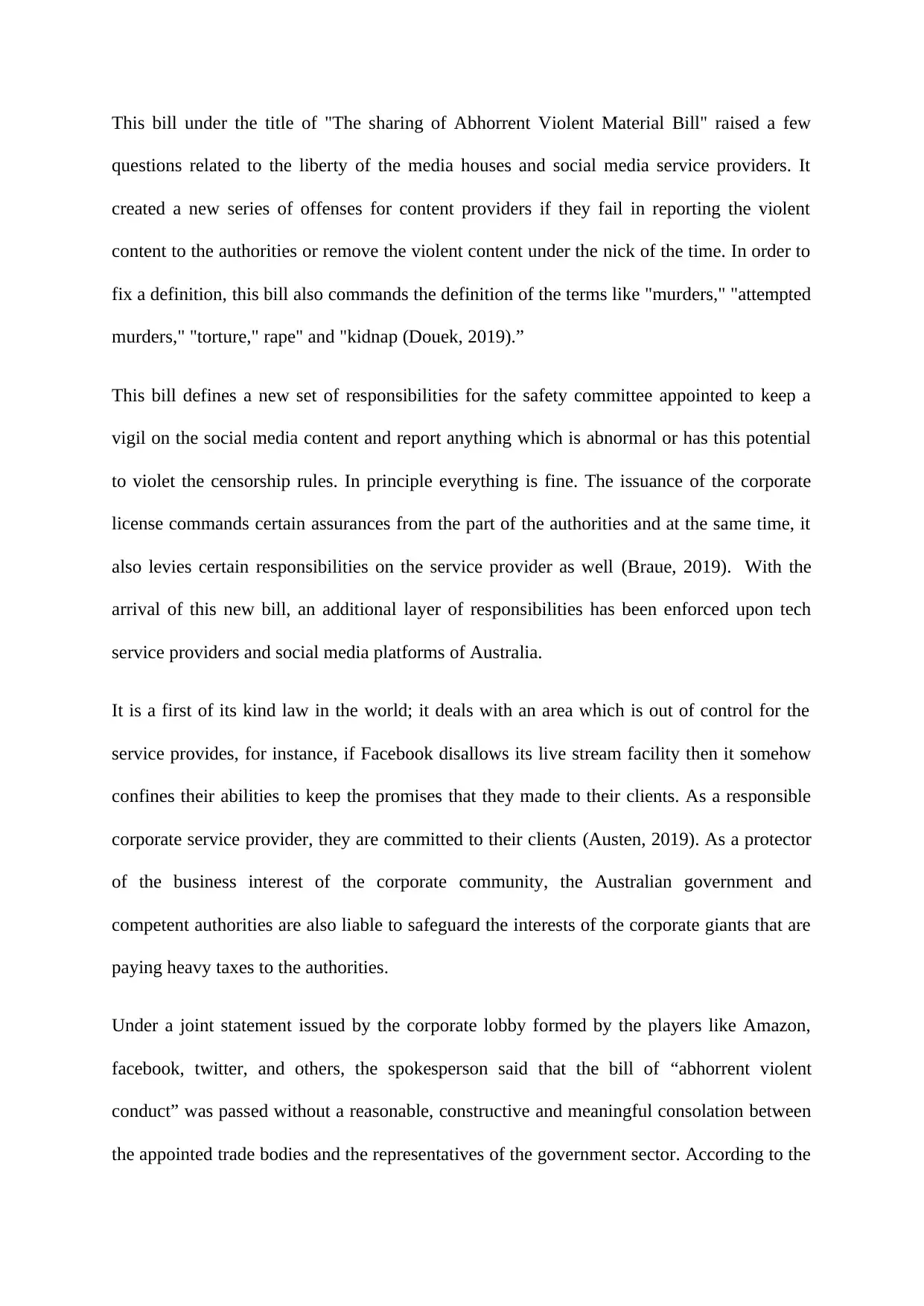
This bill under the title of "The sharing of Abhorrent Violent Material Bill" raised a few
questions related to the liberty of the media houses and social media service providers. It
created a new series of offenses for content providers if they fail in reporting the violent
content to the authorities or remove the violent content under the nick of the time. In order to
fix a definition, this bill also commands the definition of the terms like "murders," "attempted
murders," "torture," rape" and "kidnap (Douek, 2019).”
This bill defines a new set of responsibilities for the safety committee appointed to keep a
vigil on the social media content and report anything which is abnormal or has this potential
to violet the censorship rules. In principle everything is fine. The issuance of the corporate
license commands certain assurances from the part of the authorities and at the same time, it
also levies certain responsibilities on the service provider as well (Braue, 2019). With the
arrival of this new bill, an additional layer of responsibilities has been enforced upon tech
service providers and social media platforms of Australia.
It is a first of its kind law in the world; it deals with an area which is out of control for the
service provides, for instance, if Facebook disallows its live stream facility then it somehow
confines their abilities to keep the promises that they made to their clients. As a responsible
corporate service provider, they are committed to their clients (Austen, 2019). As a protector
of the business interest of the corporate community, the Australian government and
competent authorities are also liable to safeguard the interests of the corporate giants that are
paying heavy taxes to the authorities.
Under a joint statement issued by the corporate lobby formed by the players like Amazon,
facebook, twitter, and others, the spokesperson said that the bill of “abhorrent violent
conduct” was passed without a reasonable, constructive and meaningful consolation between
the appointed trade bodies and the representatives of the government sector. According to the
questions related to the liberty of the media houses and social media service providers. It
created a new series of offenses for content providers if they fail in reporting the violent
content to the authorities or remove the violent content under the nick of the time. In order to
fix a definition, this bill also commands the definition of the terms like "murders," "attempted
murders," "torture," rape" and "kidnap (Douek, 2019).”
This bill defines a new set of responsibilities for the safety committee appointed to keep a
vigil on the social media content and report anything which is abnormal or has this potential
to violet the censorship rules. In principle everything is fine. The issuance of the corporate
license commands certain assurances from the part of the authorities and at the same time, it
also levies certain responsibilities on the service provider as well (Braue, 2019). With the
arrival of this new bill, an additional layer of responsibilities has been enforced upon tech
service providers and social media platforms of Australia.
It is a first of its kind law in the world; it deals with an area which is out of control for the
service provides, for instance, if Facebook disallows its live stream facility then it somehow
confines their abilities to keep the promises that they made to their clients. As a responsible
corporate service provider, they are committed to their clients (Austen, 2019). As a protector
of the business interest of the corporate community, the Australian government and
competent authorities are also liable to safeguard the interests of the corporate giants that are
paying heavy taxes to the authorities.
Under a joint statement issued by the corporate lobby formed by the players like Amazon,
facebook, twitter, and others, the spokesperson said that the bill of “abhorrent violent
conduct” was passed without a reasonable, constructive and meaningful consolation between
the appointed trade bodies and the representatives of the government sector. According to the
⊘ This is a preview!⊘
Do you want full access?
Subscribe today to unlock all pages.

Trusted by 1+ million students worldwide
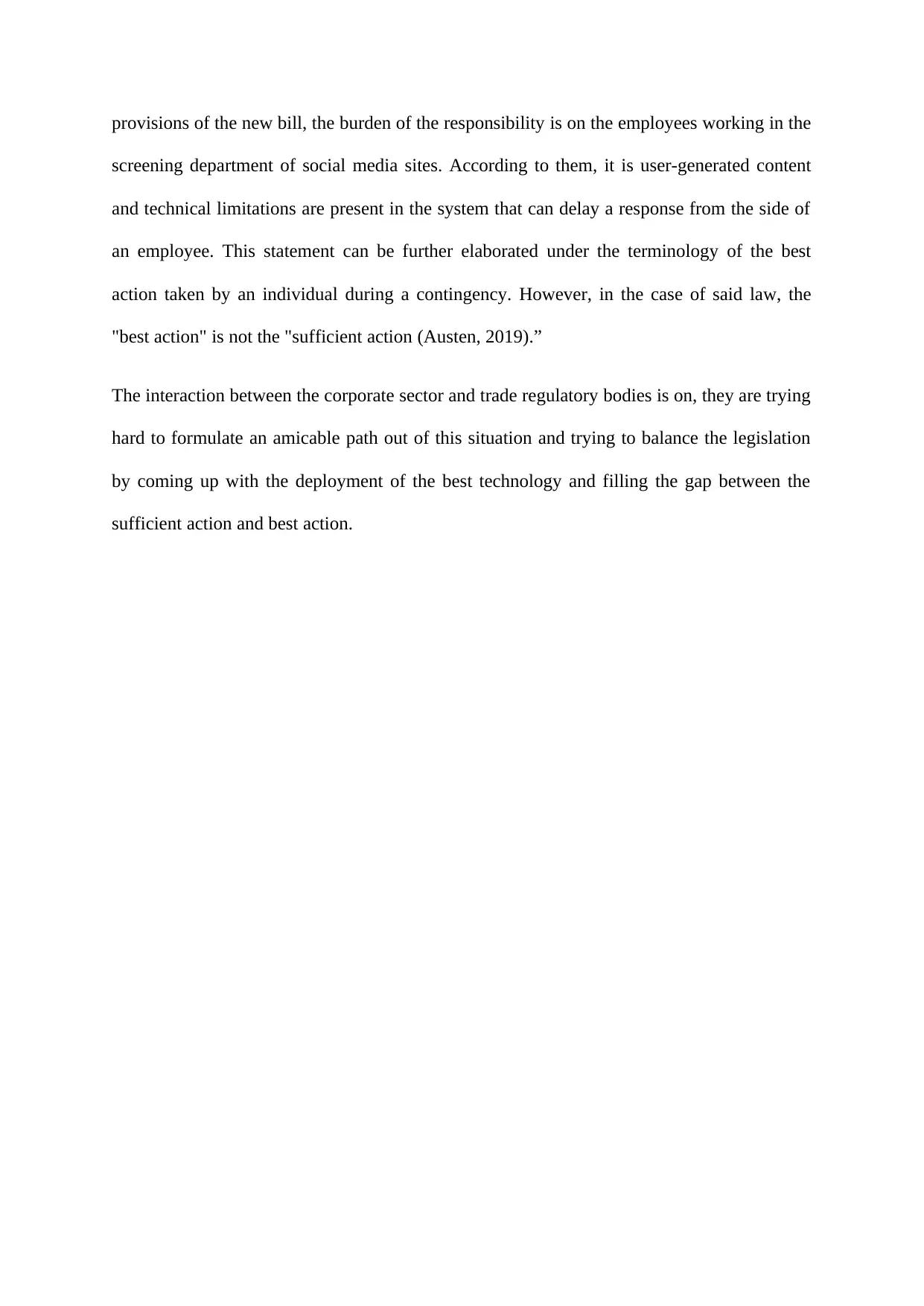
provisions of the new bill, the burden of the responsibility is on the employees working in the
screening department of social media sites. According to them, it is user-generated content
and technical limitations are present in the system that can delay a response from the side of
an employee. This statement can be further elaborated under the terminology of the best
action taken by an individual during a contingency. However, in the case of said law, the
"best action" is not the "sufficient action (Austen, 2019).”
The interaction between the corporate sector and trade regulatory bodies is on, they are trying
hard to formulate an amicable path out of this situation and trying to balance the legislation
by coming up with the deployment of the best technology and filling the gap between the
sufficient action and best action.
screening department of social media sites. According to them, it is user-generated content
and technical limitations are present in the system that can delay a response from the side of
an employee. This statement can be further elaborated under the terminology of the best
action taken by an individual during a contingency. However, in the case of said law, the
"best action" is not the "sufficient action (Austen, 2019).”
The interaction between the corporate sector and trade regulatory bodies is on, they are trying
hard to formulate an amicable path out of this situation and trying to balance the legislation
by coming up with the deployment of the best technology and filling the gap between the
sufficient action and best action.
Paraphrase This Document
Need a fresh take? Get an instant paraphrase of this document with our AI Paraphraser
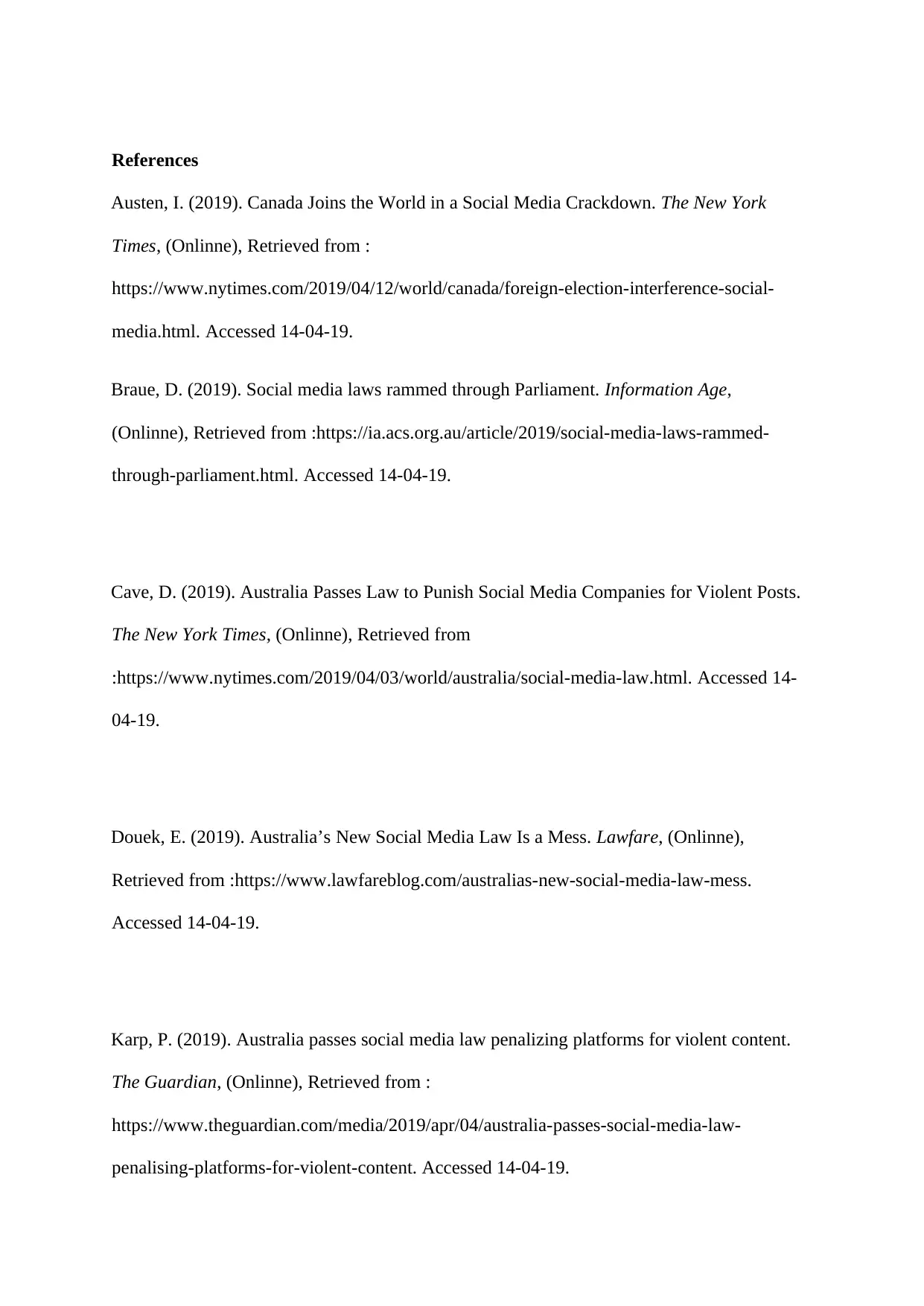
References
Austen, I. (2019). Canada Joins the World in a Social Media Crackdown. The New York
Times, (Onlinne), Retrieved from :
https://www.nytimes.com/2019/04/12/world/canada/foreign-election-interference-social-
media.html. Accessed 14-04-19.
Braue, D. (2019). Social media laws rammed through Parliament. Information Age,
(Onlinne), Retrieved from :https://ia.acs.org.au/article/2019/social-media-laws-rammed-
through-parliament.html. Accessed 14-04-19.
Cave, D. (2019). Australia Passes Law to Punish Social Media Companies for Violent Posts.
The New York Times, (Onlinne), Retrieved from
:https://www.nytimes.com/2019/04/03/world/australia/social-media-law.html. Accessed 14-
04-19.
Douek, E. (2019). Australia’s New Social Media Law Is a Mess. Lawfare, (Onlinne),
Retrieved from :https://www.lawfareblog.com/australias-new-social-media-law-mess.
Accessed 14-04-19.
Karp, P. (2019). Australia passes social media law penalizing platforms for violent content.
The Guardian, (Onlinne), Retrieved from :
https://www.theguardian.com/media/2019/apr/04/australia-passes-social-media-law-
penalising-platforms-for-violent-content. Accessed 14-04-19.
Austen, I. (2019). Canada Joins the World in a Social Media Crackdown. The New York
Times, (Onlinne), Retrieved from :
https://www.nytimes.com/2019/04/12/world/canada/foreign-election-interference-social-
media.html. Accessed 14-04-19.
Braue, D. (2019). Social media laws rammed through Parliament. Information Age,
(Onlinne), Retrieved from :https://ia.acs.org.au/article/2019/social-media-laws-rammed-
through-parliament.html. Accessed 14-04-19.
Cave, D. (2019). Australia Passes Law to Punish Social Media Companies for Violent Posts.
The New York Times, (Onlinne), Retrieved from
:https://www.nytimes.com/2019/04/03/world/australia/social-media-law.html. Accessed 14-
04-19.
Douek, E. (2019). Australia’s New Social Media Law Is a Mess. Lawfare, (Onlinne),
Retrieved from :https://www.lawfareblog.com/australias-new-social-media-law-mess.
Accessed 14-04-19.
Karp, P. (2019). Australia passes social media law penalizing platforms for violent content.
The Guardian, (Onlinne), Retrieved from :
https://www.theguardian.com/media/2019/apr/04/australia-passes-social-media-law-
penalising-platforms-for-violent-content. Accessed 14-04-19.
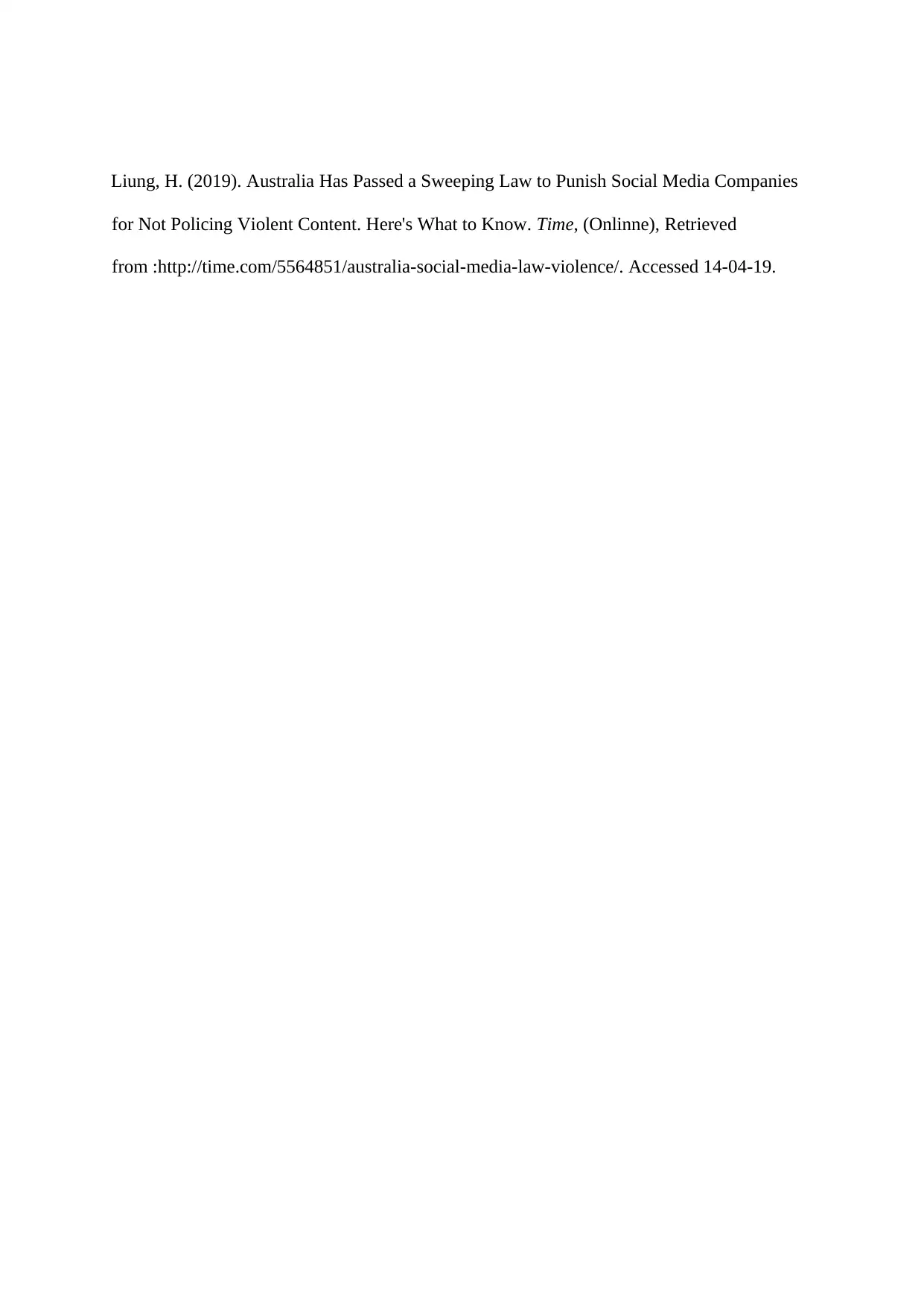
Liung, H. (2019). Australia Has Passed a Sweeping Law to Punish Social Media Companies
for Not Policing Violent Content. Here's What to Know. Time, (Onlinne), Retrieved
from :http://time.com/5564851/australia-social-media-law-violence/. Accessed 14-04-19.
for Not Policing Violent Content. Here's What to Know. Time, (Onlinne), Retrieved
from :http://time.com/5564851/australia-social-media-law-violence/. Accessed 14-04-19.
⊘ This is a preview!⊘
Do you want full access?
Subscribe today to unlock all pages.

Trusted by 1+ million students worldwide
1 out of 6
Your All-in-One AI-Powered Toolkit for Academic Success.
+13062052269
info@desklib.com
Available 24*7 on WhatsApp / Email
![[object Object]](/_next/static/media/star-bottom.7253800d.svg)
Unlock your academic potential
Copyright © 2020–2025 A2Z Services. All Rights Reserved. Developed and managed by ZUCOL.